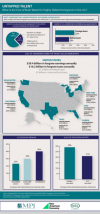The Costs of Brain Waste among Highly Skilled Immigrants in Select States
Across the United States, nearly 2 million immigrants with college degrees are unemployed or stuck in low-skilled jobs. This skill underutilization—a phenomenon also known as “brain waste”—varies significantly by state. These fact sheets explore the key factors underlying brain waste and estimate the annual earnings and state and local taxes that are unrealized as a result of this skill underutilization for highly skilled immigrants living in eight states: California, Florida, Michigan, New York, Ohio, Oregon, Texas, and Washington State.
The fact sheets accompany a national report on skill underutilization, Untapped Talent: The Costs of Brain Waste among Highly Skilled Immigrants in the United States.
The eight states were selected because they represent a mix of traditional immigrant destinations (California, Florida, New York, and Texas), two relatively new-destination states (Oregon and Washington), and two industrial states that have recently sought to attract skilled immigrants (Michigan and Ohio). Together, these study states accounted for more than 57 percent of the $39.4 billion in forgone annual earnings that highly skilled immigrants experienced across the United States.
See below for links to individual state fact sheets.
State Fact Sheets
The Costs of Brain Waste in California
California was home to 1.8 million highly skilled immigrants with at least a bachelor’s degree during the 2009-13 period. Of this group, 25 percent—or 452,000 people—were either working in low-skilled jobs or unemployed—the same rate of brain waste experienced by college educated immigrants nationally. Low-skilled employment resulted in immigrant college graduates forgoing approximately $9.4 billion in annual earnings. As a result, California experienced $694.8 million in forgone state and local tax revenue.
The Costs of Brain Waste in Florida
Florida has the fourth-largest immigrant population in the country, but ranks third in the number of highly skilled immigrants, with 608,000 during the 2009-13 period. Of this group, 32 percent—or 192,000 people—were either working in low-skilled jobs or unemployed, compared to the 25 percent rate for the United States overall. Low-skilled employment resulted in immigrant college graduates in Florida forgoing approximately $3.6 billion in annual earnings. As a result, Florida experienced $214.7 million in unrealized state and local tax revenue.
An increase in the immigrant population in Michigan has halted the state's overall population decline and contributed to its education and skills. Michigan was home to 144,000 highly skilled immigrants with at least a bachelor’s degree during the 2009-13 period. Of this group, 20 percent—or 29,000 people—were either working in low-skilled jobs or unemployed. Low-skilled employment resulted in $510.2 million in annual forgone wages among these immigrants, and as a result, Michigan experienced $48.6 million in unrealized state and local taxes.
The Costs of Brain Waste in New York
New York State was home to 878,000 highly skilled immigrants with at least a bachelor's degree during the 2009-13 period. Of this group, 27 percent—or 234,000 people—were either working in low-skilled jobs or unemployed, as compared to the 25 percent rate nationwide. Low-skilled employment resulted in immigrant college graduates in New York forgoing approximately $5 billion in annual earnings. As a result, New York experienced $594 million in unrealized state and local tax revenue. Hispanic immigrants had the highest skill underutilization rates of all racial and ethnic groups in the state.
The Costs of Brain Waste in Ohio
Ohio was home to 117,000 highly skilled immigrants with at least a bachelor's degree during the 2009-13 period. Of this group, 21 percent—or 24,000 people—were either working in low-skilled jobs or unemployed. Low-skilled employment resulted in immigrant college graduates forgoing approximately $514.5 million in annual earnings, and as a result, Ohio experienced $53 million in unrealized state and local tax revenue. Black immigrants in Ohio had the highest skill underutilization rates of all racial and ethnic groups in the state.
The Costs of Brain Waste in Oregon
Oregon was home to nearly 400,000 immigrants, 55,000 of whom had at least a bachelor's degree in 2009-13. More than one-quarter (27 percent) of these highly skilled immigrants were either working in low-skilled jobs or unemployed. As a result of this skill underutilization, they did not realize about $272 million in annual expected earnings, resulting in nearly $28 million in forgone yearly state and local tax revenue.
The Costs of Brain Waste in Texas
Texas ranks second in the size of its foreign-born population and fourth in the number of highly skilled immigrants. Texas was home to 594,000 highly skilled immigrants with at least a bachelor’s degree during the 2009-13 period. Of this group, 23 percent—or 134,000 people—either worked in low-skilled jobs or were unemployed. Low-skilled employment resulted in immigrant college graduates forgoing approximately $2.5 billion in annual earnings, and as a result, Texas experienced $167.4 million in unrealized state and local tax revenue.
The Costs of Brain Waste in Washington State
Washington State is home to nearly 1 million immigrants, a number that has tripled since 1990. This number includes 179,000 highly skilled immigrants with at least a bachelor's degree during the 2009-13 period. Of this group, 23 percent—or 41,000 people—were either working in low-skilled jobs or unemployed. Low-skilled employment resulted in immigrant college graduates in Washington State forgoing approximately $827.2 million in annual earnings. As a result, Washington experienced $74.9 million in unrealized state and local tax revenue.
Key Findings
I. Highly Skilled Immigrants by the Numbers
II. Economic Cost of Brain Waste
III. Factors Driving Brain Waste
IV. Conclusion



